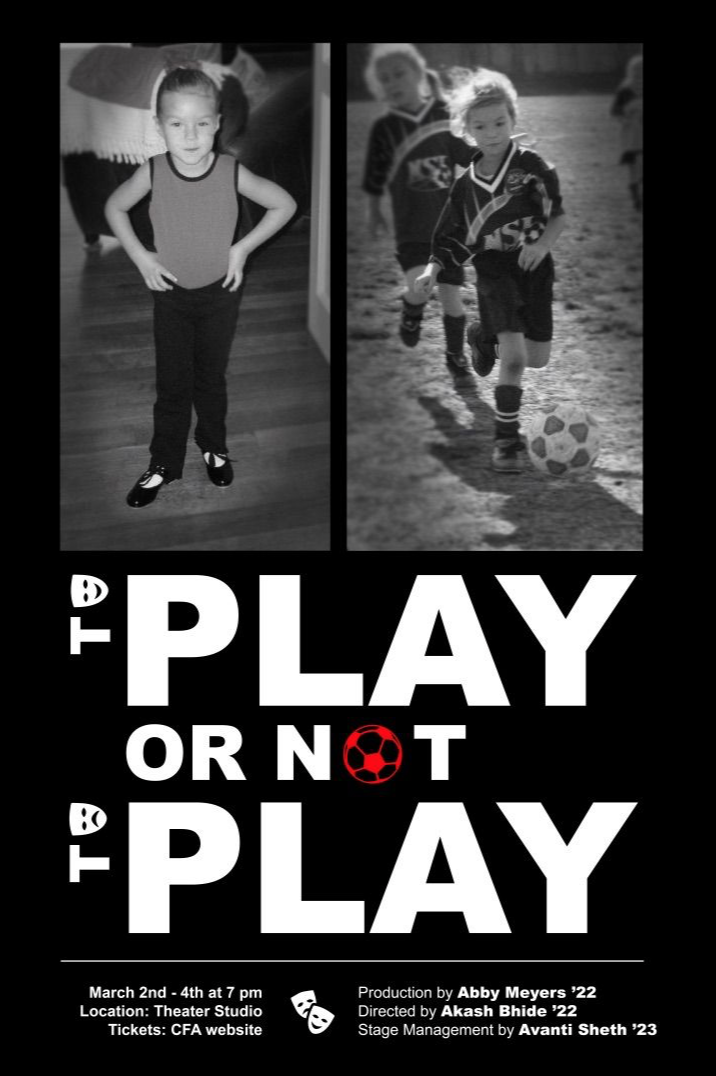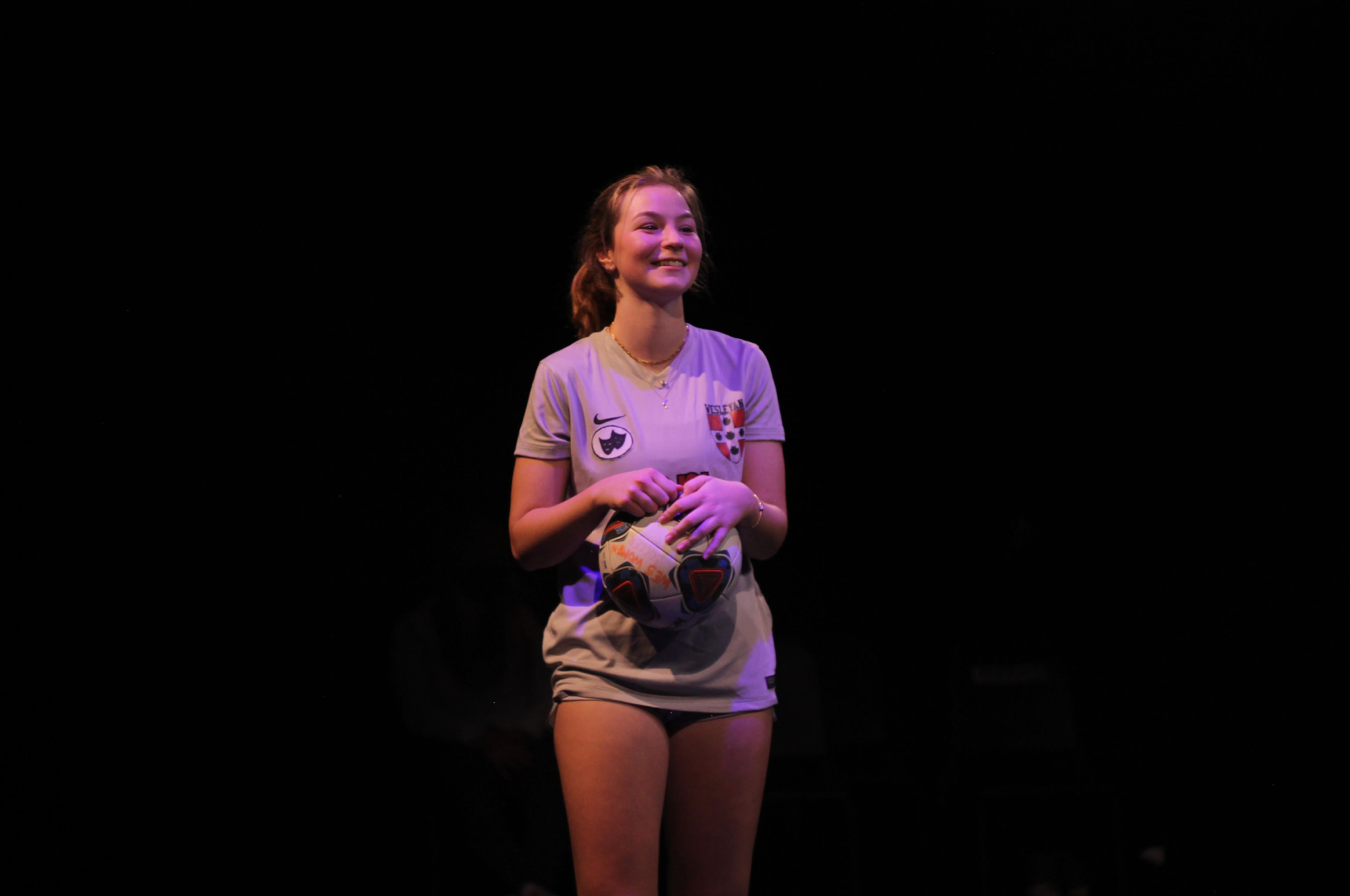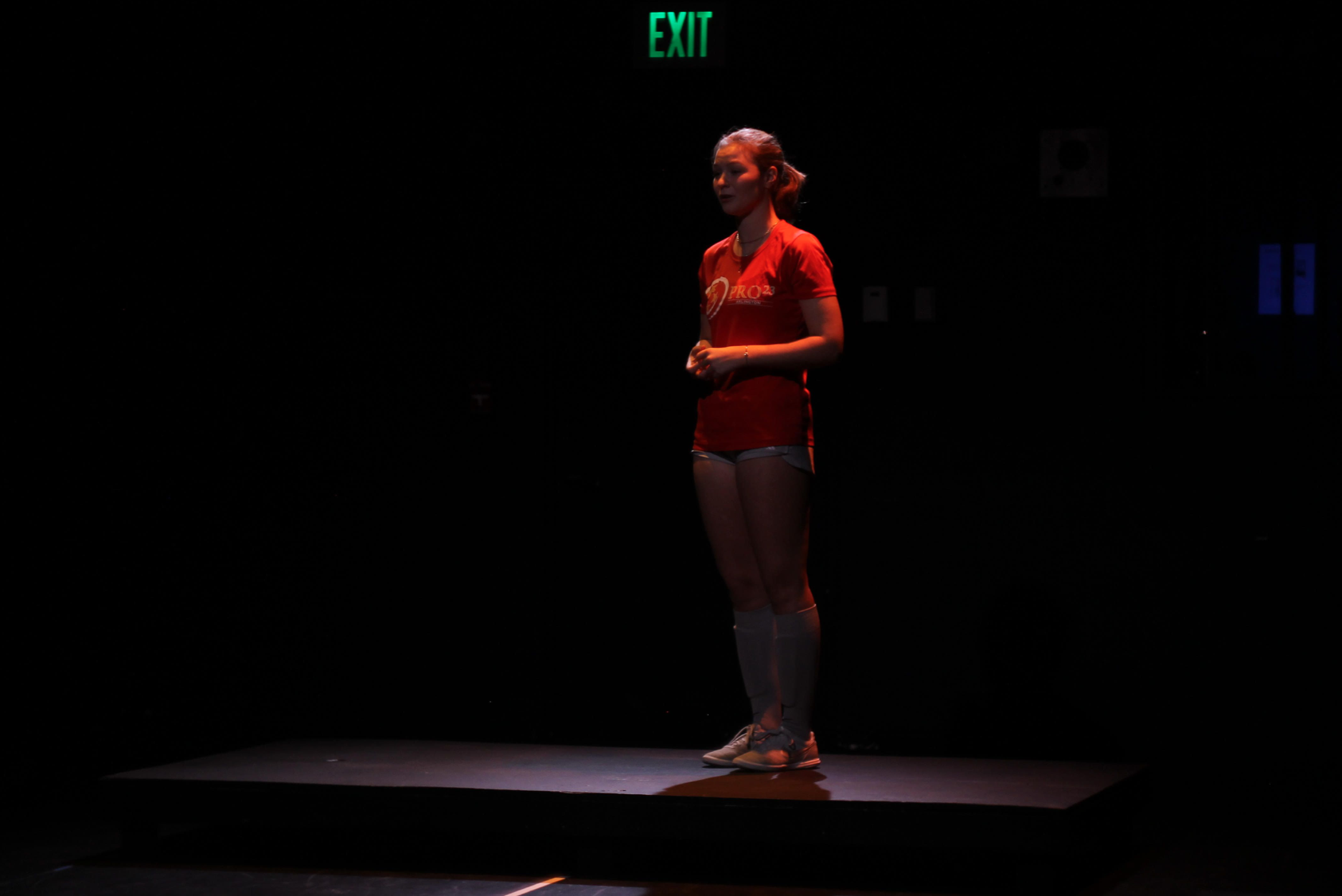
“To Play or Not to Play,” a senior theater thesis by Abby Meyers ’22, was staged in the Theater Studio on March 2, 3, and 4. The 45-minute solo performance takes the audience through a timeline of Meyers’ life, describing her experience with balancing both high-level arts and athletics from a very young age. The piece seeks to address both the divisiveness of the two niches and their many similarities. Meyers takes a personal narrative approach to telling her story, highlighting moments of contemplation, defeat, struggle and success.
The walls on the way down the stairs to the Theater Studio were lined with photos from Meyers’ childhood and young adult life: scenes from the many shows she’s taken part in, memories of herself playing soccer, and moments that Meyers spent singing in choir groups. One that stood out was a photo of Meyers on the soccer field when she was five years old.
Once we walked into the studio, we were immediately immersed in Meyers’ world. The area in the middle was lined with green fabric resembling grass that stretched from one end of the stage to the other. On either end was a goal, and in the middle was the center circle typically seen on a soccer field. Placed horizontally to the stage were two elevated rectangular platforms. The audience sat all around the stage in a theater in the round.
After a few minutes, Meyers walked in wearing her soccer uniform. She stood in the center circle and started stretching as if she was warming up for a game. She then began by giving the audience an introduction to her life, detailing how she had been deeply involved in arts and athletics from her childhood.
“I’ve been an actor and an athlete for as long as I can remember, feels like I’ve been playing soccer since before I could walk and I’ve been performing since pretty much the moment I learned to speak,” Meyers said in the opening scene.
Throughout her piece, Meyers takes the audience on a journey, describing times in her life where her two passions pushed and pulled against one another. One such moment was when she didn’t make the varsity soccer team and was not cast in her high school’s theater show because her director and coach both thought they would pose too many scheduling conflicts with each other. Therefore, heartbreakingly, she didn’t get to participate in either.
Meyers related another example of the friction between the two activities that occurred when she was 17 years old. The DC state soccer semifinals clashed with a show that she had a big role in. Suddenly, Meyers was confronted with a choice that she found impossible to make. A tense energy hung in the air during this scene. Meyers was standing in the center circle, doing another workout and contemplating what to do. In an interview with The Argus, Meyers discussed this moment.

“The whole point of the show is that I’m super indecisive, I don’t like making choices, I don’t like picking between things especially when I care deeply about them, so the hardest part for me was when I’ve been forced to choose,” Meyers said. “But to that, saying [that] I’m going to power through and I’m going to find a way to do both.”
A unique aspect of the show was the variety of workouts and warm-ups featured, reflecting Meyers’ process of finding both her physical and emotional boundaries.
“I kind of think of acting as an emotional workout, and part of what I’m trying to work through with this piece and in my paper, is the ways in which athletes and actors share this mental space, of this need to push ourselves to our absolute limits,” Meyers said.
Meyers would often incorporate these exercises while speaking directly to the audience. In some moments, her workout added to the intensity of a scene. Later in the performance, Meyers shared an experience from college. She was running back and forth between the two onstage platforms as she got a call from her mom. When she picked up her phone, her panting from running turned into breathy sobs as she told her mom how lost she felt. Weaving together the physical workout with her emotional burden was not just impactful for her, but also for the audience, granting us a window into her inner turmoil.
Although this piece was told from Meyers’ perspective, at many times, she took on the roles of the important figures from her life, such as her parents, her coaches and directors, and even versions of her younger self.
“I don’t consider myself a character actor, but I feel like to get through my own life and my experiences and represent them in a way that would be the most truthful, there had to be more people in this world than just me,” Meyers said.
Towards the beginning of the show, Meyers impersonated her eight-year-old self performing in front of her parents using a hairbrush as a makeshift microphone. While she was singing, an audio recording of when she was eight years old played over the speakers, creating a touching moment where Meyers performed a duet with her younger self.
Another character that stood out was Meyers’ theater director, an old man with a tired voice. Every time Meyers embodied him, her shoulders would hunch over and she would shift from her normal bubbly self to someone with barely any facial expression. During the scenes with dialogue, she would seamlessly move between acting as herself and her theater director, creating a funny juxtaposition between the two characters.
“It was definitely scary at first because I was like, ‘I don’t know if I know how to do this,’” Meyers said. “I feel like I did have to push myself as a performer to places that I wasn’t necessarily as comfortable with, and I feel like those characters helped me get out of my comfort zone.”
At the end of her performance, Meyers reflected on her life up to this point and started to look ahead. As she was began talking to the audience as her present self, the tone shifted. Several times in her life, Meyers explained, she was told “to just pick one.” She spoke about how, even though she had missed out on a lot of experiences and didn’t always find success, there was nothing that she would rather do than play on the soccer field with her team or stand behind the curtain just as the opening number of a show began to play.
“Being on the field as the whistle blew for my senior game and running up to my teammates and hugging them just feels so worth it in a way that I wish I could put into words better than that,” Meyers said. “The reason why I never quit anything was because those highs were worth so much more and meant so much more than any of the lows ever did.”

When asked about what she wanted to impart to her audience, Meyers spoke about Canadian journalist Malcolm Gladwell, who said that to master a skill one needs to spend 10,000 hours focusing on, crafting, and perfecting it. Meyers reflected on how her mom told her that instead of 10,000 hours, Meyers chose to put in 20,000 hours into her two passions.
“When I thought about it that way, I thought that everybody has something that they focus their 10,000 hours on—it can be anything,” Meyers said, “I hope that people came out of this show with an appreciation for their 10,000 hours and a feeling of accomplishment. What better feeling is there?”
Sabrina Ladiwala can be reached at sladiwala@wesleyan.edu.


Leave a Reply